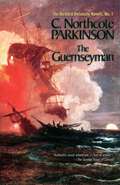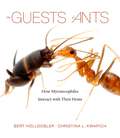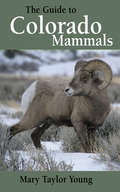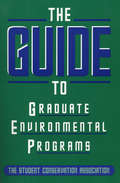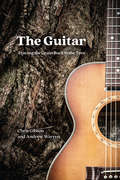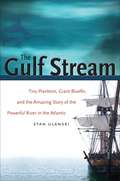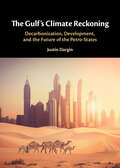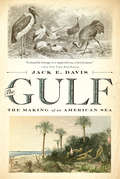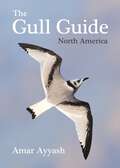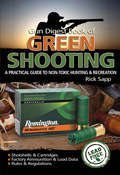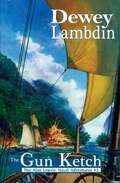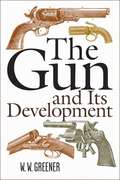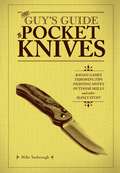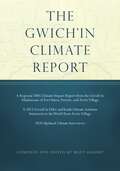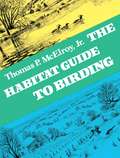- Table View
- List View
The Guadalupe Mountains of Texas
by Alan Tennant Larry Henderson Michael AllenderSince its publication in 1980, The Guadalupe Mountains of Texas has received many honors, including the Friends of the Dallas Public Library Award from the Texas Institute of Letters and recognition for its superb design from the Rounce and Coffin Club.
The Guernseyman
by C. Northcote ParkinsonRichard Delancey, inadvertently embroiled in Liverpool labor riots, sidesteps punishment by "volunteering" for the Navy. Ranked as a midshipman, he is no sooner aboard than his ship sails for the port of New York. But when the events of the American Revolution and the ongoing hostilities between England and France send him back across the sea, Delancey finds himself instrumental in defending the Isle of Jersey and, later, the Rock of Gibraltar.
The Guests of Ants: How Myrmecophiles Interact with Their Hosts
by Bert Hölldobler Christina L. KwapichA fascinating examination of socially parasitic invaders, from butterflies to bacteria, that survive and thrive by exploiting the communication systems of ant colonies. Down below, on sidewalks, in fallen leaves, and across the forest floor, a covert invasion is taking place. Ant colonies, revered and studied for their complex collective behaviors, are being infiltrated by tiny organisms called myrmecophiles. Using incredibly sophisticated tactics, various species of butterflies, beetles, crickets, spiders, fungi, and bacteria insert themselves into ant colonies and decode the colonies’ communication system. Once able to “speak the language,” these outsiders can masquerade as ants. Suddenly colony members can no longer distinguish friend from foe. Pulitzer Prize–winning author and biologist Bert Hölldobler and behavioral ecologist Christina L. Kwapich explore this remarkable phenomenon, showing how myrmecophiles manage their feat of code-breaking and go on to exploit colony resources. Some myrmecophiles slip themselves into their hosts’ food sharing system, stealing liquid nutrition normally exchanged between ant nestmates. Other intruders use specialized organs and glandular secretions to entice ants or calm their aggression. Guiding readers through key experiments and observations, Hölldobler and Kwapich reveal a universe of behavioral mechanisms by which myrmecophiles turn ants into unwilling servants. As The Guests of Ants makes clear, symbiosis in ant societies can sometimes be mutualistic, but, in most cases, these foreign intruders exhibit amazingly diverse modes of parasitism. Like other unwelcome guests, many of these myrmecophiles both disrupt and depend on their host, making for an uneasy coexistence that nonetheless plays an important role in the balance of nature.
The Guide to Colorado Mammals
by Mary Taylor YoungMary Taylor Young's latest field guide will help you discover and learn more about Colorado's native mammals. Covering 128 species, this guide explores mammals through detailed descriptions, full-color photographs, and informative sidebars. Also includes range maps, species' descriptions, a checklist, and a glossary. Outdoor enthusiasts and armchair naturalists will be delighted with this guide.Award-winning nature writer Mary Taylor Young's love of wild things led to a degree in zoology and a life devoted to nature and the environment. She has written nine books, including The Guide to Colorado Reptiles and Amphibians. Taylor Young lives in Castle Rock, Colorado.
The Guide to Graduate Environmental Programs
by Scott D. IzzoThe Guide to Graduate Environmental Programs provides over 160 profiles of graduate programs across the country that offer curricula related to the environment. Following is a description of how the book was researched and the profiles compiled: The research process began with a list, drawn up by career center staff at University of California at Santa Barbara, of 412 environmental programs, departments, and schools within universities across the country. The list was based on a literature search, queries over the Internet, and contact with environmental professionals and associations. Certificate-only programs were not included. Selection preference was given to programs mentioned repeatedly by environmental professionals, and to those drawing a more diverse student body. Of the 412 graduate programs queried, 156 programs completed and returned their surveys. Each completed survey was reworked into a profile. Schools that did not respond to the mailing were contacted twice by phone to remind them to return the survey. To supplement this information, and to ensure that the most noteworthy programs were included in the guide, additional profiles were compiled for a select number of key programs that failed to return their surveys. These latter profiles were based on literature review and personal interviews. Most of the information provided was accurate as of November 1994 - the date by which the surveys were completed - and some follow-up verification was conducted during the summer of 1996, before the book went into production. There are an ever-expanding number of programs in the environmental field, and existing programs are constantly evolving. Readers should therefore expect to continue to encounter ongoing changes in names, titles, and phone numbers.
The Guide to Walden Pond: An Exploration of the History, Nature, Landscape, and Literature of One of America's Most Iconic Places
by Robert M. ThorsonAn exploration of the history, nature, landscape, and literature of one of America&’s most iconic places This is the first guidebook to Henry David Thoreau&’s most defining place, visited by half a million people each year and widely known as the fountainhead of America's environmental consciousness. Using this guide, both armchair readers and trail-walkers alike can amble around the pond&’s shoreline, pausing at fifteen special places to learn about people, historic events, and the natural world. Thoreau will be a constant companion via quotes from Walden. Stop by stop, the place of his book will merge with the book of his place. Abundantly illustrated with photographs, drawings, and maps, this guide is a must-have for a meaningful, engaging tour of Walden Pond as well as a souvenir of a visit. Special Thanks Concord Free Public Library Concord Museum Massachusetts Department of Conservation and Recreation Thoreau Farm Trust Thoreau Society Walden Woods Project
The Guinness Book of Superlatives: The Original Book of Fascinating Facts
by BooksImagine the world before Google or Facebook, when books were the only source of recorded fact. Originally published in 1956, The Guinness Book of Superlatives is the very first book in a series that would one day become one of the most well-known and trusted brands in the world—The Guinness Book of World Records. This is the original fun and informative edition, which gathered world facts and records from the year of its publication and prior. Included within are world records and facts from the sectors of: Science Politics Economics Art Architecture Engineering Accidents and disasters Human achievements The natural world And many more! Pick up this entertaining reference book, and expand your knowledge of the world as it was more than sixty years ago.
The Guitar: Tracing the Grain Back to the Tree
by Chris Gibson Andrew WarrenGuitars inspire cult-like devotion: an aficionado can tell you precisely when and where their favorite instrument was made, the wood it is made from, and that wood’s unique effect on the instrument’s sound. In The Guitar, Chris Gibson and Andrew Warren follow that fascination around the globe as they trace guitars all the way back to the tree. The authors take us to guitar factories, port cities, log booms, remote sawmills, Indigenous lands, and distant rainforests, on a quest for behind-the-scenes stories and insights into how guitars are made, where the much-cherished guitar timbers ultimately come from, and the people and skills that craft those timbers along the way. Gibson and Warren interview hundreds of people to give us a first-hand account of the ins and outs of production methods, timber milling, and forest custodianship in diverse corners of the world, including the Pacific Northwest, Madagascar, Spain, Brazil, Germany, Japan, China, Hawaii, and Australia. They unlock surprising insights into longer arcs of world history: on the human exploitation of nature, colonialism, industrial capitalism, cultural tensions, and seismic upheavals. But the authors also strike a hopeful note, offering a parable of wider resonance—of the incredible but underappreciated skill and care that goes into growing forests and felling trees, milling timber, and making enchanting musical instruments, set against the human tendency to reform our use (and abuse) of natural resources only when it may be too late. The Guitar promises to resonate with anyone who has ever fallen in love with a guitar.
The Guitar: Tracing the Grain Back to the Tree
by Chris Gibson Andrew WarrenGuitars inspire cult-like devotion: an aficionado can tell you precisely when and where their favorite instrument was made, the wood it is made from, and that wood’s unique effect on the instrument’s sound. In The Guitar, Chris Gibson and Andrew Warren follow that fascination around the globe as they trace guitars all the way back to the tree. The authors take us to guitar factories, port cities, log booms, remote sawmills, Indigenous lands, and distant rainforests, on a quest for behind-the-scenes stories and insights into how guitars are made, where the much-cherished guitar timbers ultimately come from, and the people and skills that craft those timbers along the way. Gibson and Warren interview hundreds of people to give us a first-hand account of the ins and outs of production methods, timber milling, and forest custodianship in diverse corners of the world, including the Pacific Northwest, Madagascar, Spain, Brazil, Germany, Japan, China, Hawaii, and Australia. They unlock surprising insights into longer arcs of world history: on the human exploitation of nature, colonialism, industrial capitalism, cultural tensions, and seismic upheavals. But the authors also strike a hopeful note, offering a parable of wider resonance—of the incredible but underappreciated skill and care that goes into growing forests and felling trees, milling timber, and making enchanting musical instruments, set against the human tendency to reform our use (and abuse) of natural resources only when it may be too late. The Guitar promises to resonate with anyone who has ever fallen in love with a guitar.
The Guitar: Tracing the Grain Back to the Tree
by Chris Gibson Andrew WarrenGuitars inspire cult-like devotion: an aficionado can tell you precisely when and where their favorite instrument was made, the wood it is made from, and that wood’s unique effect on the instrument’s sound. In The Guitar, Chris Gibson and Andrew Warren follow that fascination around the globe as they trace guitars all the way back to the tree. The authors take us to guitar factories, port cities, log booms, remote sawmills, Indigenous lands, and distant rainforests, on a quest for behind-the-scenes stories and insights into how guitars are made, where the much-cherished guitar timbers ultimately come from, and the people and skills that craft those timbers along the way. Gibson and Warren interview hundreds of people to give us a first-hand account of the ins and outs of production methods, timber milling, and forest custodianship in diverse corners of the world, including the Pacific Northwest, Madagascar, Spain, Brazil, Germany, Japan, China, Hawaii, and Australia. They unlock surprising insights into longer arcs of world history: on the human exploitation of nature, colonialism, industrial capitalism, cultural tensions, and seismic upheavals. But the authors also strike a hopeful note, offering a parable of wider resonance—of the incredible but underappreciated skill and care that goes into growing forests and felling trees, milling timber, and making enchanting musical instruments, set against the human tendency to reform our use (and abuse) of natural resources only when it may be too late. The Guitar promises to resonate with anyone who has ever fallen in love with a guitar.
The Gulf Stream
by Stan UlanskiCoursing through the Atlantic Ocean is a powerful current with a force 300 times that of the mighty Amazon. Ulanski explores the fascinating science and history of this sea highway known as the Gulf Stream, a watery wilderness that stretches from the Caribbean to the North Atlantic. Spanning both distance and time, Ulanski's investigation reveals how the Gulf Stream affects and is affected by every living thing that encounters it--from tiny planktonic organisms to giant bluefin tuna, from ancient mariners to big-game anglers. He examines the scientific discovery of ocean circulation, the role of ocean currents in the settlement of the New World, and the biological life teeming in the stream.
The Gulf of Mexico Research Initiative: A Vision for Twenty-First-Century Science (America's Third Coast Series)
by Justin ShapiroThe Gulf of Mexico Research Initiative (GoMRI) was a ten-year, $500 million research program to investigate the impacts of oil, dispersed oil, and dispersants on the ecosystems of the Gulf of Mexico following the 2010 Deepwater Horizon disaster. Research institutions in the Gulf region and the National Oceanic and Atmospheric Agency (NOAA) worked together to conduct applied and comprehensive scientific research on the Gulf of Mexico. GoMRI left behind a substantial body of scientific knowledge about oil spills and strengthened scientific capacity to respond to such calamities. In The Gulf of Mexico Research Initiative: A Vision for Twenty-First-Century Science, Justin Shapiro writes the history of GoMRI and its role in organizing and facilitating a large-scale scientific response to the Deepwater Horizon oil spill. Chapters in the book highlight the significance of the Gulf of Mexico Research Initiative in the history of maritime oil spills and outlines its mission. Subsequent chapters discuss GoMRI’s adaptive management structure, transparent data policies, and extensive outreach efforts in the Gulf region. Finally, Shapiro emphasizes GoMRI’s comprehensive synthesis of oil spill science and its impact on future scientific responses to major disasters. For this in-depth investigation, Shapiro spent years corresponding with the GoMRI Research Board, scientists who received funding from the Initiative, and other actors who played important roles in its history. Shapiro also provides insights into how a similar scientific initiative might be organized to improve society’s ability to understand and act in the aftermath of ecological catastrophes. The Gulf of Mexico Research Initiative serves as both a work of history and an instruction manual that can guide responses to future disasters.
The Gulf of Mexico: A Maritime History
by John S. Sledge“[Sledge] rightfully celebrates and affirms the southern sea’s enriching past and gives readers reason to want for its wholesome and meaningful future.” —Jack E. Davis, Pulitzer Prize–winning author of The Gulf: The Making of an American SeaThe Gulf of Mexico presents a compelling, salt-streaked narrative of the earth’s tenth largest body of water. In this beautifully written and illustrated volume, John S. Sledge explores the people, ships, and cities that have made the Gulf’s human history and culture so rich. Many famous figures who sailed the Gulf’s viridian waters are highlighted, including Ponce de León, Robert Cavelier de La Salle, Francis Drake, Elizabeth Agassiz, Ernest Hemingway, and Charles Dwight Sigsbee at the helm of the doomed Maine. Gulf events of global historical importance are detailed, such as the only defeat of armed and armored steamships by wooden sailing vessels, the first accurate deep-sea survey and bathymetric map of any ocean basin, the development of shipping containers by a former truck driver frustrated with antiquated loading practices, and the worst environmental disaster in American annals.Occasionally shifting focus ashore, Sledge explains how people representing a gumbo of ethnicities built some of the world’s most exotic cities—Havana, way station for conquistadores and treasure-filled galleons; New Orleans, the Big Easy, famous for its beautiful French Quarter, Mardi Gras, and relaxed morals; and oft-besieged Veracruz, Mexico’s oldest city, founded in 1519 by Hernán Cortés. In the modern era the Gulf has become critical to energy production, fisheries, tourism, and international trade, even as it is threatened by pollution and climate change. The Gulf of Mexico is a work of verve and sweep that illuminates both the risks of life on the water and the riches that come from its bounty.
The Gulf's Climate Reckoning: Decarbonization, Development, and the Future of the Petro-States
by Justin DarginIn a world demanding climate action, the oil-rich Gulf states face a defining crossroads: can they transform economies built on fossil fuels into resilient, climate-aligned powerhouses? This timely and original study offers a rigorous, multidimensional analysis of how Saudi Arabia, the United Arab Emirates, and Qatar are navigating the high-stakes transition to decarbonization. Weaving together historical political economy, postcolonial state formation, economic pressures, geopolitical realignments, and environmental imperatives, it explores the difficult trade-offs and strategic decisions forging the region's trajectory. Through incisive analysis, it reveals emerging policy innovations, evolving social contracts, and institutional strategies that are redefining the Gulf's energy future—while critically evaluating the macroeconomic consequences of climate-driven transformation. Essential reading for policymakers, financiers, energy professionals, multilateral institutions, and scholars, The Gulf's Climate Reckoning offers an intellectual and strategic framework for understanding the Gulf's climate-industrial transformation and its far-reaching implications for the emerging global energy and governance landscape.
The Gulf: The Making of An American Sea
by Jack E. Davis<P>The tragic collision between civilization and nature in the Gulf of Mexico becomes a uniquely American story in this environmental epic. <P>When painter Winslow Homer first sailed into the Gulf of Mexico, he was struck by its "special kind of providence." Indeed, the Gulf presented itself as America’s sea—bound by geography, culture, and tradition to the national experience—and yet, there has never been a comprehensive history of the Gulf until now. And so, in this rich and original work that explores the Gulf through our human connection with the sea, environmental historian Jack E. Davis finally places this exceptional region into the American mythos in a sweeping history that extends from the Pleistocene age to the twenty-first century. <P>Significant beyond tragic oil spills and hurricanes, the Gulf has historically been one of the world's most bounteous marine environments, supporting human life for millennia. Davis starts from the premise that nature lies at the center of human existence, and takes readers on a compelling and, at times, wrenching journey from the Florida Keys to the Texas Rio Grande, along marshy shorelines and majestic estuarine bays, profoundly beautiful and life-giving, though fated to exploitation by esurient oil men and real-estate developers. <P>Rich in vivid, previously untold stories, The Gulf tells the larger narrative of the American Sea—from the sportfish that brought the earliest tourists to Gulf shores to Hollywood’s engagement with the first offshore oil wells—as it inspired and empowered, sometimes to its own detriment, the ethnically diverse groups of a growing nation. Davis' pageant of historical characters is vast, including: the presidents who directed western expansion toward its shores, the New England fishers who introduced their own distinct skills to the region, and the industries and big agriculture that sent their contamination downstream into the estuarine wonderland. Nor does Davis neglect the colorfully idiosyncratic individuals: the Tabasco king who devoted his life to wildlife conservation, the Texas shrimper who gave hers to clean water and public health, as well as the New York architect who hooked the “big one” that set the sportfishing world on fire. <P>Ultimately, Davis reminds us that amidst the ruin, beauty awaits its return, as the Gulf is, and has always been, an ongoing story. Sensitive to the imminent effects of climate change, and to the difficult task of rectifying grievous assaults of recent centuries, The Gulf suggests how a penetrating examination of a single region's history can inform the country's path ahead. <P><b>Winner of the 2018 Pulitzer Prize for History</b>
The Gull Guide: North America
by Amar AyyashThe definitive photographic guide to North American gullsGull identification can be challenging for even the most seasoned birder. While these birds are common to coasts, lakes, and rivers, they exhibit remarkable plumage changes related to age, which is sometimes complicated by similarities between species and a readiness to hybridize. This book provides an invaluable identification guide to all regularly occurring gull species and subspecies throughout North America. It is packed with the very latest research on field identification, updated taxonomy, current distribution trends, color maps, and helpful notes on natural history, aging, and molt. The Gull Guide integrates the essential elements that are critical to understanding gulls, setting an entirely new standard for identifying and enjoying these marvelous birds.Features more than 1,800 superb color photosCovers 36 gull species as well as 7 of the most commonly encountered hybrid gullsGives equal attention to rarities from Asia, Europe, and South AmericaDescribes the key characteristics of all age groups, from juvenile through adult plumagesInnovative photo collages give side-by-side comparisons, enabling readers to distinguish between similar species and avoid common pitfalls associated with gull identificationComes with a one-of-a-kind &“cheat sheet&” describing key features of select Larus speciesA must for the bookshelf of every birder and ornithologist
The Gull Next Door: A Portrait of a Misunderstood Bird (Wild Nature Press)
by Marianne TaylorA uniquely personal meditation on Britain's gulls by one of today's leading wildlife writersFrom a distance, gulls are beautiful symbols of freedom over the oceanic wilderness. Up close, however, they can be loud, aggressive and even violent. Yet gulls fascinate birdwatchers, and seafarers regard them with respect and affection. The Gull Next Door explores the natural history of gulls and their complicated relationship with humans.Marianne Taylor grew up in an English seaside town where gulls are ever present. Today, she is a passionate advocate for these underappreciated birds. In this book, Taylor looks at the different gull species and sheds light on all aspects of the lives of gulls—how they find food, raise families, socialize and migrate across sea, coastland and countryside. She discusses the herring gull, Britain's best-known and most persecuted gull species, whose numbers are declining at an alarming rate. She looks at gulls in legend, fiction and popular culture, and explains what we can do to protect gull populations around the world.The Gull Next Door reveals deeper truths about these remarkable birds. They are thinkers and innovators, devoted partners and parents. They lead long lives and often indulge their powerful drive to explore and travel. But for all these natural gifts, many gull species are struggling to survive in the wild places they naturally inhabit, which is why they are now exploiting the opportunities of human habitats. This book shows how we might live more harmoniously with these majestic yet misunderstood birds.
The Gun Digest Book of Green Shooting
by Rick SappDiscover the practical impact of environmental shooting regulations in the field and on the shooting range.In Green Shooting, you'll learn why environmentally-friendly shooting is important and why it is increasingly mandated by state and federal legislation.Review currently-offered eco-friendly ammunition and reloading components and understand their benefits to the shooter and reloader.Understand performance-enhancing modifications necessary to maximize benefit of the new products.Try out practical tips and techniques for environmentally-neutral shooting.
The Gun Digest Buyers' Guide to Guns
by Ken RamageFor many gun owners, the story is the same - so many guns to choose from, and so little time (and possibly patience) to review all the various reference needed to get the full picture of modern-era market. This new Gun Digest guide helps readers make the most of research time, without loosing any reliability, by coupling authoritative reports on the latest handguns, rifles and shotguns and 3,500+ photographs, with distinct catalogs of modern commercial arms and used guns with realistic prices.
The Gun Ketch
by Dewey LambdinIt's 1786, and Alan Lewrie has his own ship at last: the Alacrity. Small but deadly, the Alacrity prowls the waters of the Caribbean, protecting British merchants from pirates. But Lewrie is still the same old rakehell he always was. Scandal sets tongues wagging in the Bahamas as the young captain thumbs his nose at propriety and makes a few well-planned conquests on land before sailing off to take on Calico Jack Finney, the boldest pirate in the Caribbean.
The Gun and Its Development (Greenhill Military Paperback Ser.)
by W. W. GreenerFirst published in Great Britain in 1881 and subsequently revised nine times between then and 1910, The Gun and Its Development traces the fascinating history of weaponry: the obscure, ancient origins of the slingshot and the bow, the invention of the crossbow, possibly around 1000 AD; the introduction of gunpowder into Europe in the fourteenth century; the development of sporting and military guns over the centuries thereafter; and the rise of modern, mass-produced firearms in the early twentieth century.Chapters cover early to modern handguns; gunpowder ignition methods from fuses and flintlocks to percussion fulminates; shotguns; hammerless guns; ejector guns; the history of the firearms industry; manufacturing methods and their development in Britain, America, and elsewhere; how to use and handle different types of guns; ballistics; the development of rifling and smokeless powder; and much more. Copiously illustrated with photographs and marvelous engravings, The Gun and Its Development is the classic, authoritative reference work on the subject, certain to be of great interest to marksmen, hunters, gun collectors, and anyone interested in military or industrial history.
The Guy's Guide to Pocket Knives: Badass Games, Throwing Tips, Fighting Moves, Outdoor Skills and Other Manly Stuff
by Mike YarbroughPACKED WITH OVER 50 POCKET KNIFE TRICKS, IDEAS, AND ACTIVITIES, FROM FUN GAMES AND PROJECTS TO BADASS FIGHTING MOVES AND SURVIVAL TIPS.You should never be without a trusty pocket knife, nor should you lack the skills to wield it properly and with purpose. The Guy’s Guide to Pocket Knives is sure to sharpen your skills and hone your appreciation for the pocket knife with nostalgic, humorous and informative sections on:• History and Evolution• Blade Types and Uses• Sharpening Guides• Games and Pastimes• Whittling Projects• Outdoor Survival Skills• Throwing Techniques
The Gwich’in Climate Report
by Matt GilbertA regional climate impact and adaptation report from the Gwich'in Athabascans of Interior Alaska, The Gwich’in Climate Report is a compilation of transcribed interviews between Matt Gilbert and northern Alaska Gwich’in Athabascan community members, elders, hunters, and trappers. The book explores Gwich’in insight and wisdom about ecology, climate, and the drastic effects of climate change on their landscapes and culture. These interview subjects are at a “ground zero” of climate change, and their voices are largely absent from popular research on and discussion of the topic. Their traditional knowledge of Arctic flora and fauna, forestation, landforms, meteorology, airstream behavior, and river hydrology makes a significant contribution to the documentation of climate change. In addition, Gilbert bridges the Gwich’in worldview and that of Western science by including factual substantiation and citations that corroborate key observations in the Gwich’in transcripts. A text that matters for its cultural and historical significance—as well as its potential impact on the way science and policy are conducted in rural Alaska and on public lands—TheGwich’in Climate Report will be of interest to residents of and stakeholders in the communities it represents as well as researchers concerned with on-the-ground conditions of ecosystems and Indigenous peoples most directly affected by climate change.
The Habitat Guide to Birding
by Thomas P. McelroyThe United States is blessed with birds, a vast and richly varied population that changes considerably as the habitat changes from forest, to meadow, to marsh. As Thomas P. McElroy puts it in this unique birding guide, "Birds are everywhere . . . and this fact alone provides innumerable ecological equations to challenge the most curious of intellects." This is not a guide that answers only "What bird is it? but the deeper, more fascinating questions such as these: Why is it there? How does it survive? How does it contribute to the ecology of its surroundings? The answers to these questions, and many more, carry the birdwatcher well beyond lists and into a more involving, more satisfying means of observing nature.
The Habitats Directive in its EU Environmental Law Context: European Nature’s Best Hope? (Routledge Research in EU Law)
by An Cliquet Charles-Hubert Born Hendrik Schoukens Delphine Misonne Geert Van HoorickThis book analyses the Habitats Directive; one of the most prominent piece of EU environmental legislation of the past decades. Seen by some as the cornerstone of Europe’s nature conservation policy, among other measures the Directive established the so-called "Natura 2000" ecological network, which covers more than 18% of the surface of the EU. However, despite the fact the Directive was adopted over twenty years ago only 17% of the protected habitats and species in Europe are being adequately protected while 10-60 % of animal species remain under threat. In light of the limited success and the contested nature of the Habitats Directive so far this book examines the successes and failures of the Habitats Directive from a legal and political angle. The book brings together international experts to consider the application, implementation and future of the Habitats Directive in order to assess whether the Habitats Directive is resilient enough to tackle biodiversity loss in the twenty- first century. Particular emphasis is put on the legal regime attached to the Natura 2000 network and its possible impact on land development and the relationship between the Habitats Directive and other topics including liability for ecological damage and transboundary nature conservation.

